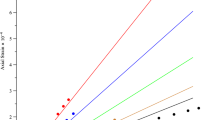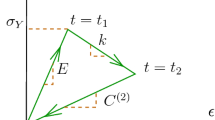Abstract
An implicit constitutive relation is proposed to study transversely isotropic bodies. The relation is obtained assuming the existence of a Gibbs potential that depends on the second Piola–Kirchhoff stress tensor, from which the Green Saint-Venant strain tensor is obtained as the derivative with respect to the stress. The responses of unconstrained as well as inextensible bodies are studied, and some boundary value problems are analysed. An inextensible body, where the constraint of inextensibility appears only in tension is also considered.
Similar content being viewed by others
References
Rajagopal KR (2003) On implicit constitutive theories. Appl Math 48:279–319
Rajagopal KR (2007) The elasticity of elasticity. Z Angew Math Phys 58:309–317
Rajagopal KR (2011) Conspectus of concepts of elasticity. Math Mech Solids 16:536–562
Truesdell CA, Noll W (2004) In: Antman SS (ed) The non-linear field theories of mechanics, 3rd edn. Springer, Berlin
Rajagopal KR, Srinivasa AR (2007) On the response of non-dissipative solids. Proc R Soc A 463:357–367
Rajagopal KR, Srinivasa AR (2009) On a class of non-dissipative solids that are not hyperelastic. Proc R Soc A 465:493–500
Spencer AJM (1972) Deformations of fibre-reinforced materials. Oxford University Press, London
Spencer AJM (1984) Constitutive theory for strongly anisotropic solids. In: Spencer AJM (ed) Continuum theory of the mechanics of fibre-reinforced composites. Springer, New York, pp 1–32
Pipkin AC (1974) Finite deformations of ideal fibre-reinforced composites. In: Sendeokyi GP (ed) Composite materials, vol 2. Academic Press, New York
Rogers TG (1984) Finite deformation and stress in idea fibre-reinforced materials. In: Spencer AJM (ed) Continuum theory of the mechanics of fibre-reinforced composites. Springer, New York, pp 33–72
Adkins JE, Rivlin RS (1955) Large elastic deformations of isotropic materials X. Reinforcement by intextensible cords. Proc R Soc A 248:201–223. Also see Barenblatt GI, Joseph DD (eds.) (1997) Collected papers of R.S. Rivlin, Springer Verlag, New York Inc., pp. 488–510
Truesdell CA, Toupin R (1960) The classical field theories. In: Flügge S (ed) Handbuch der Physik, vol III/1. Springer, Berlin
Spencer AJM (1971) Theory of invariants. In: Eringen AC (ed) Continuum physics, vol 1. Academic Press, New York, pp 239–353
Bustamante R, Rajagopal KR (2015) Study of a new class of non-linear inextensible elastic bodies. Z Angew Math Phys 66:3663–3677
John F (1975) Partial differential equations. Springer, New York
Beskos DE (1972) Universal solutions for fiber-reinforced compressible, isotropic elastic materials. J Elast 2:153–168
Beatty MF (1978) General solutions in the equilibrium theory of inextensible elastic materials. Acta Mech 29:119–126
Pipkin AC (1975) Finite axisymmetric deformation of ideal fibre-reinforced composites. Q J Mech Appl Math 28:271–284
Kassianidis F, Ogden RW, Merodio J, Pence TJ (2008) Azimuthal shear of a transversely isotropic elastic solid. Math Mech Solids 13:690–724
Acknowledgements
K. R. Rajagopal thanks the National Science Foundation and the Office of Naval Research for support of this work.
Author information
Authors and Affiliations
Corresponding author
Additional information
Publisher's Note
Springer Nature remains neutral with regard to jurisdictional claims in published maps and institutional affiliations.
Appendix: A generalization of the problem of biaxial extension/compression and shear of a slab
Appendix: A generalization of the problem of biaxial extension/compression and shear of a slab
For the problem of the biaxial extension/compression and shear of a slab described in Sect. 5.1, the following deformation that is more general than (34) is also possible for the stress given by (32):
where \(\lambda _i\), \(i=1,2,3\), and \(\kappa _1\), \(\kappa _2\) are constants. The deformation gradient is
from which we can obtain \(J=(\lambda _1\lambda _2-\kappa _1\kappa _2)\lambda _3\) and
From (3) and (32) and using the above expression for J we obtain for the non-zero components of the second Piola–Kirchhoff stress tensor
The above expressions for \(\mathbf {S}\), \(\mathbf {E}\) and \(\mathbf {a}_0\) (that is given in (33)) can be replaced in (6) obtaining implicit relations for unconstrained solids that are more general than (38)–(41).
In the case of an inextensible slab using (133) and (33) in (9) we obtain (compare with (54))
and the non-zero components of \(\mathbf {S}_\mathrm {a}\) from (134) considering (15) are
These expressions for the components of \(\mathbf {S}_\mathrm {a}\) and (133) must be used in (26) to obtain a generalization of (50)–(53).
Rights and permissions
About this article
Cite this article
Bustamante, R., Rajagopal, K.R. A class of transversely isotropic non-linear elastic bodies that is not Green elastic. J Eng Math 127, 2 (2021). https://doi.org/10.1007/s10665-021-10094-7
Received:
Accepted:
Published:
DOI: https://doi.org/10.1007/s10665-021-10094-7




